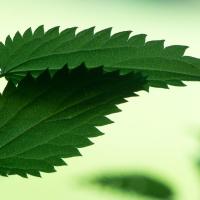Annual nettle
Urtica urens
Urtica urens, commonly known as small nettle or dwarf nettle, is a flowering plant belonging to the nettle family (Urticaceae). Here's some information about this plant:
Description:
-
Growth Form: Small nettle is a herbaceous annual or short-lived perennial plant.
-
Stems and Leaves: The stems and leaves are covered with stinging hairs that release irritant chemicals upon contact, causing a stinging sensation.
-
Leaves: The leaves are opposite, roughly toothed, and typically heart-shaped. They are smaller in size compared to those of the more well-known stinging nettle (Urtica dioica).
-
Flowers: The small, inconspicuous flowers are greenish and arranged in clusters.
-
Roots: Small nettle has a fibrous root system.
Habitat:
-
Small nettle is native to Europe but has become naturalized in various regions worldwide.
-
It often thrives in disturbed areas, cultivated fields, gardens, and along roadsides.
Identification Features:
-
Stinging Hairs: Like other nettles, small nettle is characterized by stinging hairs on the stems and leaves.
-
Opposite Leaves: The opposite arrangement of leaves is a key feature, with the leaves being smaller than those of larger nettle species.
-
Heart-shaped Leaves: The leaves are typically heart-shaped, adding to their distinctive appearance.
-
Greenish Flowers: The flowers, while not showy, are arranged in clusters and have a greenish hue.
Uses:
- Small nettle has been historically used in traditional medicine for various purposes, similar to other nettle species.
Caution:
- The stinging hairs on the plant can cause skin irritation. Care should be taken when handling small nettle to avoid contact with bare skin.
Ecological Impact:
- In some regions, small nettle can behave as a weed and colonize disturbed habitats.
Culinary and Medicinal Uses:
- While not as commonly used as larger nettle species, small nettle has been utilized in traditional medicine and, in some cases, as a culinary ingredient.









Plant Protection Products
- ⭑⭑⭑
- ⭑⭑⭑
- ⭑⭑⭑
- ⭑⭑⭑
- ⭑⭑⭑
- ⭑⭑⭑
- ⭑⭑⭑
- ⭑⭑⭑
- ⭑⭑⭑
- ⭑⭑⭑
- N/A
- N/A
- N/A
- N/A
- N/A
- N/A
- N/A
- ⭑⭑⭑
- ⭑⭑⭑
- N/A
- N/A
- N/A
- ⭑⭑⭑
- ⭑⭑⭑
- ⭑⭑⭑
- ⭑⭑⭑
- N/A
- N/A
- N/A
- ⭑⭑⭑
- ⭑⭑⭑
- N/A
- N/A
- N/A
- N/A
- N/A
- N/A
- N/A
- N/A
- N/A
- N/A
- N/A
- N/A
- N/A
- N/A
- N/A
- N/A
- ⭑⭑⭑
- N/A
- N/A
- N/A
- N/A
- N/A
- N/A
- N/A
- N/A
- N/A